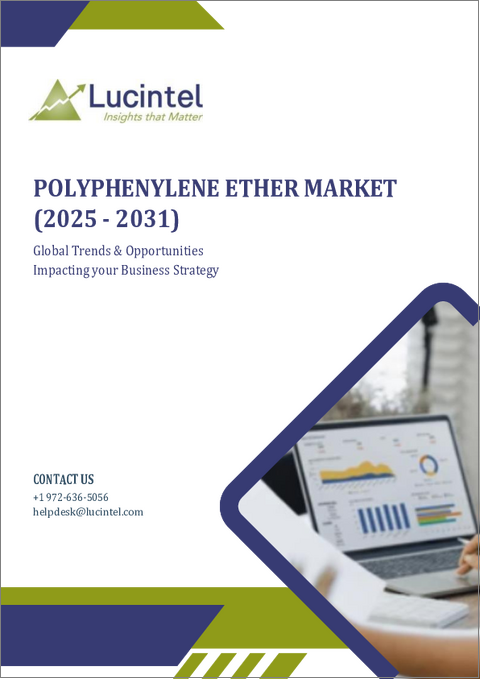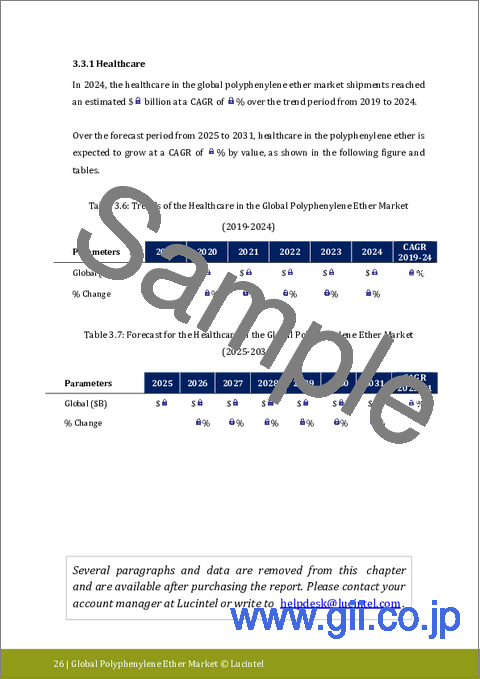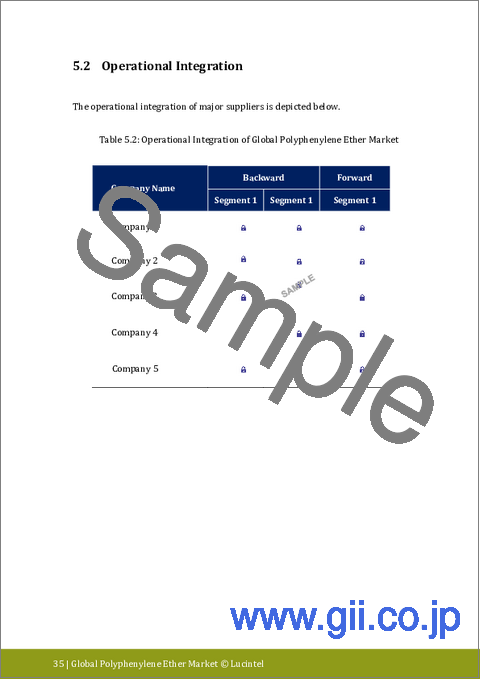|
|
市場調査レポート
商品コード
1665117
ポリフェニレンエーテル市場レポート:動向、予測、競合分析 (2031年まで)Polyphenylene Ether Market Report: Trends, Forecast and Competitive Analysis to 2031 |
||||||
カスタマイズ可能
適宜更新あり
|
|||||||
| ポリフェニレンエーテル市場レポート:動向、予測、競合分析 (2031年まで) |
|
出版日: 2025年02月27日
発行: Lucintel
ページ情報: 英文 150 Pages
納期: 3営業日
|
全表示
- 概要
- 目次
世界のポリフェニレンエーテル市場の将来性は、医療、自動車、航空宇宙、電気・電子市場での機会により有望視されています。世界のポリフェニレンエーテル市場は、2025年から2031年までのCAGRが7.5%で、2031年までに推定24億米ドルに達すると予想されています。この市場の主な促進要因は、自動車や医療機器への応用が増加していることです。
- Lucintelは、種類別ではPPE/PSが予測期間中に最も高い成長を遂げると予測しています。
- 地域別では、アジア太平洋が引き続き最大地域で、これは同地域に広範な化学・製造部門が存在するためです。
ポリフェニレンエーテル市場の戦略的成長機会
近年、ポリフェニレンエーテル市場では、さまざまな用途で戦略的成長機会が生まれています。このような成長機会は、技術の進歩、需要の増加、前向きな市場見通しによってもたらされています。
- 自動車産業の拡大:自動車産業では高性能材料が求められており、PPEの成長見通しが生まれています。この市場開拓は、耐久性と耐熱性に優れたPPE素材の開発によってもたらされています。
- 電子・電気用途:エレクトロニクス産業は、主に電気絶縁特性を求めてPPEを求めています。成長機会には、熱的・電気的性能基準を満たすハイテク機器や部品用のPPEの開発が含まれます。
- 医療分野の開発:PPEは医療市場、特に医療機器や装置でますます普及しています。新たな開発機会としては、医療用途に合わせた、より優れた生体適合性と滅菌特性を持つPPE素材の開発が挙げられます。
- 再生可能エネルギー源の統合:クリーンエネルギー資源と物理的エネルギー資源の組み合わせは、風力タービンのブレードやソーラーパネルの建設に求められています。極端な気象条件下でも高い性能を維持する複合材料やプラスチックの開発に成長機会が集中しています。
- 消費財と包装:PPE素材の有利な特性により、消費財や包装におけるPPEの使用が増加しています。PPEの引張強度を活用しつつ、有害な特性を緩和するような新しい包装資材を設計する機会もあります。
上記の発展領域が、ポリフェニレンエーテル市場の成長を妨げる障壁を取り払いつつあります。このような開発は、創造性と革新性を奨励することで、成長のための新たな道を提供するものです。
ポリフェニレンエーテル市場の促進要因・課題
ポリフェニレンエーテル市場は、技術開発や政治的要因の影響を受け、いくつかの重要な促進要因・課題に直面しています。これらの要因は、市場構造と成長機会を大きく左右します。
促進要因
- 技術進歩:PPE材料の熱的・電気的特性の急速な向上が市場の変化を促進しています。これらの改良により、材料は高性能用途の増加する要件を満たし、用途の裾野を広げることができます。
- 自動車とエレクトロニクスにおける需要の増加:PPEの需要は、自動車産業とエレクトロニクス産業の影響を大きく受けています。これらの分野で効率的な素材へのニーズが高まっており、PPEメーカーの市場は拡大しています。
- 持続可能性の重視:環境意識の高まりにより、環境に優しいプロセスを採用し、リサイクル可能なPPE素材を生産するメーカーが増えています。この戦略は、現在の市場動向や規制上の要求に合致しています。
- 応用分野の拡大:医療や再生可能エネルギーなどの市場でPPEの採用が増加しており、成長が見込まれています。この進化は市場の範囲を広げ、特定のPPE製品に対する需要を増大させています。
- 先端素材への規制支援:先端材料を支持する政策や基準は、PPEの生産と応用を強化します。こうした規制の遵守は革新的なプロセスを支援し、PPE製品の消費市場を拡大します。
課題:
- 高い製造コスト:高度なPPE素材に関連する生産コストは、収益性と競争力に影響を与える大きなものとなる可能性があります。この問題に対処することは、市場の成長とアクセシビリティを維持する上で極めて重要です。
- 規制遵守の複雑さ:PPE素材に関する規制の枠組みを理解することは難しいです。さまざまな市場で多数の規制が存在するため、かなりのリソースと専門知識が必要となり、市場参入や拡大を複雑にしています。
- サプライチェーンの混乱:原材料の不足や物流の途絶といった問題は、PPEの製造と供給を混乱させる可能性があります。市場の安定を維持し、需要を満たすためには、こうした混乱を管理することが不可欠です。
ポリフェニレンエーテル市場に影響を与える促進要因・課題は、技術革新と戦略的計画の機会を示唆しています。イノベーションと効果的なプランニングを取り入れることで、企業は市場をナビゲートし、特定された成長分野を活用することができます。
目次
第1章 エグゼクティブサマリー
第2章 世界のポリフェニレンエーテル市場:市場力学
- イントロダクション、背景、分類
- サプライチェーン
- 業界の促進要因と課題
第3章 市場動向と予測分析 (2019年~2031年)
- マクロ経済動向 (2019~2024年) と予測 (2025~2031年)
- 世界のポリフェニレンエーテル市場の動向 (2019~2024年) と予測 (2025~2031年)
- 世界のポリフェニレンエーテル市場:種類別
- PPE/PP
- PPE/PA
- PPE/PS
- 世界のポリフェニレンエーテル市場:用途別
- 医療
- 自動車
- 航空宇宙
- 電気・電子
- その他
第4章 地域別の市場動向と予測分析 (2019年~2031年)
- 世界のポリフェニレンエーテル市場:地域別
- 北米のポリフェニレンエーテル市場
- 欧州のポリフェニレンエーテル市場
- アジア太平洋のポリフェニレンエーテル市場
- その他地域のポリフェニレンエーテル市場
第5章 競合分析
- 製品ポートフォリオ分析
- 運用統合
- ポーターのファイブフォース分析
第6章 成長機会と戦略分析
- 成長機会分析
- 世界のポリフェニレンエーテル市場の成長機会:種類別
- 世界のポリフェニレンエーテル市場の成長機会:用途別
- 世界のポリフェニレンエーテル市場の成長機会:地域別
- 世界のポリフェニレンエーテル市場の新たな動向
- 戦略的分析
- 新製品の開発
- 世界のポリフェニレンエーテル市場の生産能力拡大
- 世界のポリフェニレンエーテル市場における企業合併・買収 (M&A)、合弁事業
- 認証とライセンシング
第7章 主要企業のプロファイル
- Asahi Kasei
- SABIC
- Mitsubishi Engineering-Plastics
- RTP
- Sumitomo Chemical
- LyondellBasell
- Polyplastics
- Celanese
- Ensinger
- Saudi Basic Industries
The future of the global polyphenylene ether market looks promising with opportunities in the healthcare, automotive, aerospace, and electricals & electronics markets. The global polyphenylene ether market is expected to reach an estimated $2.4 billion by 2031 with a CAGR of 7.5% from 2025 to 2031. The major drivers for this market are the increasing application of this product in automobile and healthcare devices.
- Lucintel forecasts that, within the type category, PPE/PS is expected to witness the highest growth over the forecast period.
- In terms of regions, APAC will remain the largest region due to the presence of an extensive chemicals and manufacturing sector in the region.
Gain valuable insights for your business decisions with our comprehensive 150+ page report.
Emerging Trends in the Polyphenylene Ether Market
With the evolving processes within the polyphenylene ether market, changes in technology and the needs of end users can be observed. The necessary performance and sustainability requirements are not only altering material properties but also transforming the methods of their production and application.
- Demand for Advanced Materials: The increasing demand for PPE that incorporates higher thermal, chemical, and electrical insulation properties is a catalyst for innovations. These materials are being used more widely in the automotive and electronics industries that require high performance. This trend is forcing manufacturers to create more sophisticated formulations and PPE composites.
- Corporate Social Responsibility: There is a growing emphasis on how products are manufactured to account for environmental considerations. To reduce waste and inefficient energy consumption, firms are adopting recycling systems and clean production technologies. This trend outlines the efficient yielding of products in the market according to global sustainability norms.
- New Applications of Extended Reach: PPE is expanding into non-traditional spheres of service. New industries, such as healthcare, renewable energy, and consumer goods, are exploring the use of PPE for its properties. This diversification is creating new advanced markets and increasing the demand for tailored PPE products.
- Advancements in Production Technologies: Additive manufacturing, automation, and other advancements in production technologies are improving the efficiency of the PPE manufacturing process. These enhancements are elevating quality and decreasing material costs, allowing high-performance PPE to be used in more areas.
- Regulatory and Compliance Pressures: Regulations and legal standards concerning the environment and health and safety are impacting the production and use of PPE. These regulations compel manufacturers to develop products favorable to regulatory requirements. This trend is propelling the shift towards safer and cleaner PPE.
Recent Developments in the Polyphenylene Ether Market
Recent developments in the polyphenylene ether market are influenced by technological advancements, the expansion of application areas, and changes in regulations. Such developments are emerging in the industry and affecting the market.
- Advancement in High-Performance PPE Materials: Emerging formulations of PPE are providing enhanced thermal and electrical protection. Due to better performance and reliability, these materials are increasingly being used in complex applications, such as automotive parts and electronic devices.
- Sustainable Production Practices: More attention is being directed towards sustainability, with many companies implementing green production methods and recycling technologies. Companies are adopting this strategy due to regulations and customers' willingness to buy more environmentally responsible products, which alters manufacturing practices and material choices.
- Expansion of PPE Applications: PPE is extending its usage to newer industries, such as healthcare and renewable energy. This suggests that improvements in material properties will facilitate the adoption of new applications, thus broadening the market for specialized PPE.
- Research and Development in Manufacturing: Technological advances, such as automation and additive manufacturing, are boosting the efficiency and quality of PPE manufacturing processes. These innovations make it easier and cheaper to produce advanced PPE designs.
- Regulatory Compliance and Standards: Stringent regulations have compelled end users to adopt safer and greener PPE. Companies are making greater efforts to meet new standards, which in turn shapes product development processes and marketing strategies.
These advances are significantly transforming the polyphenylene ether market, encouraging innovation, greener practices, and the expansion of applications. The market is addressing these challenges, influencing its growth and direction in the coming years.
Strategic Growth Opportunities for Polyphenylene Ether Market
In recent years, strategic growth opportunities in the polyphenylene ether market have emerged across different applications. Such opportunities have been prompted by technological advancements, rising demand, and a positive market outlook.
- Automotive Industry Expansion: High-performance materials are in demand in the automotive industry, creating growth prospects for PPE. This market growth has been driven by the development of more durable and heat-resistant PPE materials.
- Electronics and Electrical Applications: The electronics industry seeks PPE primarily for its electrical insulation properties. Growth opportunities include advancing PPE for high-tech devices and components to meet thermal and electrical performance criteria.
- Healthcare Sector Development: PPE is becoming increasingly popular in the healthcare market, particularly in medical equipment and devices. New opportunities include developing PPE materials with better biocompatibility and sterilization properties tailored for medical applications.
- Integration of Renewable Energy Sources: The combination of clean energy resources and physical energy resources is sought in the construction of wind turbine blades and solar panels. Opportunities for growth focus on developing composites and plastics that maintain high performance under extreme weather conditions.
- Consumer Goods and Packaging: The use of PPE in consumer goods and packaging is rising due to the advantageous properties of PPE materials. Opportunities include designing novel wrapping materials that leverage the tensile strength of PPE while mitigating harmful properties.
These thrust areas are breaking down barriers that would otherwise hinder the growth of the polyphenylene ether market. These developments provide new avenues for growth by encouraging creativity and innovation.
Polyphenylene Ether Market Driver and Challenges
The polyphenylene ether market faces several critical drivers and challenges, influenced by technological development and political factors. These factors significantly regulate market structure and growth opportunities.
Drivers:
- Technological Improvements: Rapid advancements in the thermal and electrical properties of PPE materials are driving market changes. These improvements enable materials to meet the increasing requirements of high-performance applications and broaden their application base.
- Increasing Demand in Automotive and Electronics: Demand for PPE is heavily influenced by the automotive and electronics industries. The rising need for efficient materials in these sectors is expanding the market for PPE manufacturers.
- Focus on Sustainability: Growing environmental consciousness is prompting more producers to adopt eco-friendly processes and produce recyclable PPE materials. This strategy aligns with current market trends and regulatory demands.
- Expanding Application Areas: The increasing adoption of PPE in markets like healthcare and renewable energy is promising growth. This evolution is broadening the market's scope and increasing demand for specific PPE products.
- Regulatory Support for Advanced Materials: Policies and standards favoring advanced materials enhance the production and application of PPE. Compliance with these regulations supports innovative processes and broadens the consumption market for PPE products.
Challenges:
- High Production Costs: The production costs associated with advanced PPE materials can be significant, affecting profitability and competitiveness. Addressing this issue is crucial for sustaining market growth and accessibility.
- Regulatory Compliance Complexities: Navigating regulatory frameworks for PPE materials can be challenging. The multitude of regulations across various markets demands substantial resources and expertise, complicating market entry or expansion.
- Supply Chain Disruptions: Issues such as raw material scarcity and logistical breakdowns can disrupt PPE manufacturing and supply. Managing these disruptions is essential for maintaining market stability and meeting demand.
The drivers and challenges impacting the polyphenylene ether market suggest opportunities for innovation and strategic planning. By embracing innovation and effective planning, businesses can navigate the market and capitalize on identified growth areas.
List of Polyphenylene Ether Companies
Companies in the market compete on the basis of product quality offered. Major players in this market focus on expanding their manufacturing facilities, R&D investments, infrastructural development, and leverage integration opportunities across the value chain. With these strategies polyphenylene ether companies cater increasing demand, ensure competitive effectiveness, develop innovative products & technologies, reduce production costs, and expand their customer base. Some of the polyphenylene ether companies profiled in this report include-
- Asahi Kasei
- SABIC
- Mitsubishi Engineering-Plastics
- RTP
- Sumitomo Chemical
- LyondellBasell
- Polyplastics
- Celanese
- Ensinger
- Saudi Basic Industries
Polyphenylene Ether by Segment
The study includes a forecast for the global polyphenylene ether market by type, application, and region.
Polyphenylene Ether Market by Type [Analysis by Value from 2019 to 2031]:
- PPE/PP
- PPE/PA
- PPE/PS
Polyphenylene Ether Market by Application [Analysis by Value from 2019 to 2031]:
- Healthcare
- Automotive
- Aerospace
- Electricals & Electronics
- Others
Polyphenylene Ether Market by Region [Analysis by Value from 2019 to 2031]:
- North America
- Europe
- Asia Pacific
- The Rest of the World
Country Wise Outlook for the Polyphenylene Ether Market
In recent years, the Polyphenylene Ether (PPE) market has experienced significant growth due to innovative technologies, adaptation of various frameworks, and evolving market needs. Key countries such as the United States, China, Germany, and Japan are leading these changes. Recent trends indicate increasing diversification and specialization in the PPE industry.
- US: Demand from the automotive and electronics sectors is supporting growth in the US PPE market. Highlights of these developments include new PPE blends that offer improved thermal and electrical properties required for sophisticated applications. There is a shift towards best practices as organizations invest in recycling PPE materials.
- China: China's PPE market is rapidly growing, driven by industry development and policies that encourage high-tech initiatives. The country is investing resources in developing advanced manufacturing technologies for PPE products to enhance cost efficiency and quality. The internal market is also expanding, fueled by the growing automotive and domestic electronics sectors.
- Germany: Germany is leveraging its strong engineering and automotive industries to foster opportunities within the PPE market. Recent advancements include the introduction of PPE composites with better physical properties than older materials. There is also a focus on meeting high marketing requirements related to eco-friendly standards, reusable materials, and reducing carbon emissions.
- India: India offers growing opportunities in the PPE market, providing quality and cost-efficient solutions. Recent developments include introducing affordable PPE for industrial, automotive, and electrical applications. Support from the Indian government for manufacturing and technology modernization is conducive to growth and attracting foreign direct investment.
- Japan: Japan is at the forefront of evolving PPE technology, especially in the electronics and automotive industries. Recent advancements include synthesizing PPE with improved thermal and chemical stability. Japan is also expanding into new areas of PPE, aiming to deploy smart manufacturing systems and broaden its applications, including medical devices and clean energy.
Features of the Global Polyphenylene Ether Market
Market Size Estimates: Polyphenylene ether market size estimation in terms of value ($B).
Trend and Forecast Analysis: Market trends (2019 to 2024) and forecast (2025 to 2031) by various segments and regions.
Segmentation Analysis: Polyphenylene ether market size by type, application, and region in terms of value ($B).
Regional Analysis: Polyphenylene ether market breakdown by North America, Europe, Asia Pacific, and Rest of the World.
Growth Opportunities: Analysis of growth opportunities in different types, applications, and regions for the polyphenylene ether market.
Strategic Analysis: This includes M&A, new product development, and competitive landscape of the polyphenylene ether market.
Analysis of competitive intensity of the industry based on Porter's Five Forces model.
If you are looking to expand your business in this or adjacent markets, then contact us. We have done hundreds of strategic consulting projects in market entry, opportunity screening, due diligence, supply chain analysis, M & A, and more.
This report answers following 11 key questions:
- Q.1. What are some of the most promising, high-growth opportunities for the polyphenylene ether market by type (PPE/PP, PPE/PA, and PPE/PS), application (healthcare, automotive, aerospace, electricals & electronics, and others), and region (North America, Europe, Asia Pacific, and the Rest of the World)?
- Q.2. Which segments will grow at a faster pace and why?
- Q.3. Which region will grow at a faster pace and why?
- Q.4. What are the key factors affecting market dynamics? What are the key challenges and business risks in this market?
- Q.5. What are the business risks and competitive threats in this market?
- Q.6. What are the emerging trends in this market and the reasons behind them?
- Q.7. What are some of the changing demands of customers in the market?
- Q.8. What are the new developments in the market? Which companies are leading these developments?
- Q.9. Who are the major players in this market? What strategic initiatives are key players pursuing for business growth?
- Q.10. What are some of the competing products in this market and how big of a threat do they pose for loss of market share by material or product substitution?
- Q.11. What M&A activity has occurred in the last 5 years and what has its impact been on the industry?
Table of Contents
1. Executive Summary
2. Global Polyphenylene Ether Market: Market Dynamics
- 2.1: Introduction, Background, and Classifications
- 2.2: Supply Chain
- 2.3: Industry Drivers and Challenges
3. Market Trends and Forecast Analysis from 2019 to 2031
- 3.1. Macroeconomic Trends (2019-2024) and Forecast (2025-2031)
- 3.2. Global Polyphenylene Ether Market Trends (2019-2024) and Forecast (2025-2031)
- 3.3: Global Polyphenylene Ether Market by Type
- 3.3.1: PPE/PP
- 3.3.2: PPE/PA
- 3.3.3: PPE/PS
- 3.4: Global Polyphenylene Ether Market by Application
- 3.4.1: Healthcare
- 3.4.2: Automotive
- 3.4.3: Aerospace
- 3.4.4: Electricals & Electronics
- 3.4.5: Others
4. Market Trends and Forecast Analysis by Region from 2019 to 2031
- 4.1: Global Polyphenylene Ether Market by Region
- 4.2: North American Polyphenylene Ether Market
- 4.2.1: North American Polyphenylene Ether Market by Type: PPE/PP, PPE/PA, and PPE/PS
- 4.2.2: North American Polyphenylene Ether Market by Application: Healthcare, Automotive, Aerospace, Electricals & Electronics, and Others
- 4.3: European Polyphenylene Ether Market
- 4.3.1: European Polyphenylene Ether Market by Type: PPE/PP, PPE/PA, and PPE/PS
- 4.3.2: European Polyphenylene Ether Market by Application: Healthcare, Automotive, Aerospace, Electricals & Electronics, and Others
- 4.4: APAC Polyphenylene Ether Market
- 4.4.1: APAC Polyphenylene Ether Market by Type: PPE/PP, PPE/PA, and PPE/PS
- 4.4.2: APAC Polyphenylene Ether Market by Application: Healthcare, Automotive, Aerospace, Electricals & Electronics, and Others
- 4.5: ROW Polyphenylene Ether Market
- 4.5.1: ROW Polyphenylene Ether Market by Type: PPE/PP, PPE/PA, and PPE/PS
- 4.5.2: ROW Polyphenylene Ether Market by Application: Healthcare, Automotive, Aerospace, Electricals & Electronics, and Others
5. Competitor Analysis
- 5.1: Product Portfolio Analysis
- 5.2: Operational Integration
- 5.3: Porter's Five Forces Analysis
6. Growth Opportunities and Strategic Analysis
- 6.1: Growth Opportunity Analysis
- 6.1.1: Growth Opportunities for the Global Polyphenylene Ether Market by Type
- 6.1.2: Growth Opportunities for the Global Polyphenylene Ether Market by Application
- 6.1.3: Growth Opportunities for the Global Polyphenylene Ether Market by Region
- 6.2: Emerging Trends in the Global Polyphenylene Ether Market
- 6.3: Strategic Analysis
- 6.3.1: New Product Development
- 6.3.2: Capacity Expansion of the Global Polyphenylene Ether Market
- 6.3.3: Mergers, Acquisitions, and Joint Ventures in the Global Polyphenylene Ether Market
- 6.3.4: Certification and Licensing
7. Company Profiles of Leading Players
- 7.1: Asahi Kasei
- 7.2: SABIC
- 7.3: Mitsubishi Engineering-Plastics
- 7.4: RTP
- 7.5: Sumitomo Chemical
- 7.6: LyondellBasell
- 7.7: Polyplastics
- 7.8: Celanese
- 7.9: Ensinger
- 7.10: Saudi Basic Industries




